Text
Atelocynus microtis
This odd-looking canine is called a short-eared dog. They are so elusive, though, that they are often called “ghost dogs.” Sightings of them are very rare, which makes research on them difficult.

There’s been a lot of confusion over what the short-eared dog is. It used to be in the lycalopex genus with the zorros and the cerdocyon genus with the crab-eating fox, who it resembles, but now it’s in its own genus- atelocynus.

Short-eared dogs live in the Amazon rainforest in Peru, Columbia, Ecuador, Bolivia, and Brazil. They try to live far away from people, making them highly susceptible to habitat loss. Because of this it is suspected that their population is decreasing, but because sightings of them have always been rare it’s hard to estimate how many are left.
Studies of short-eared dog scat suggests that they eat lots of fruit, rodents, and fish. The fish in their diets along with their partially webbed feet could mean that short-eared dogs spend a lot of time in water, similar to the bush dog.
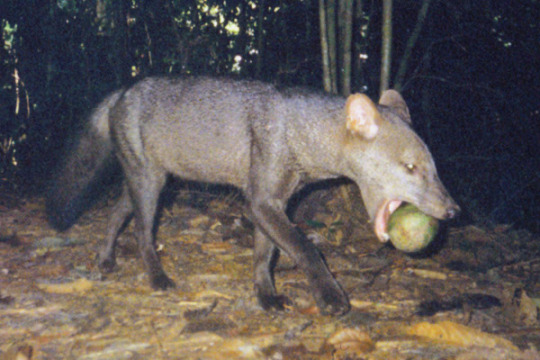
Much of what is known about these elusive animals comes from one short-eared dog named Oso, who was found when he was a puppy by a logger. He was then raised with pet dogs until a wildlife veterinarian named Renata Leite Pitman took over his care. By observing how Oso found food and interacted with other animals, Pitman learned about parts of the short-eared dogs’ life that scientists previously knew almost nothing about.
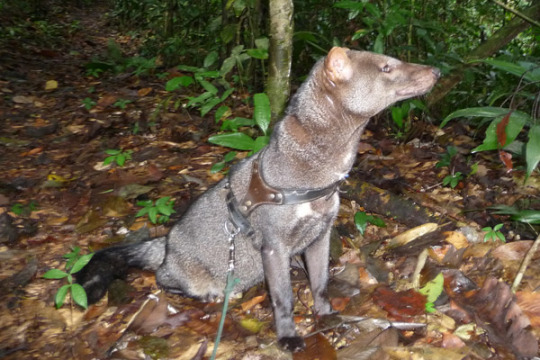
Before Pitman’s work with Oso, virtually nothing was known about short-eared dog vocalization, or the sounds they make. The veterinarian observed that Oso was very quiet but whined or “roared” when he was uncomfortable, and he occasionally made an unusual call that was “similar to some species of owl calls.”
When Oso was around 4 years old he was released into the wild with a tracker, allowing researchers to continue to learn about short-eared dogs.
I rate these very mysterious ghost dogs 13/10. They have a very distinctive look.

Photo credits:
(1) Galo Zapata-Rios (2) Owlcation (3) Renata Leite Pitman (4) Renata Leite Pitman (5) eMammal
#short eared dog#animal#animals#nature#wildlife#canine#wild animals#world#canid#dog#South America#South American animals#short-eared dog#canines#long post sorry
2K notes
·
View notes
Text
Lycalopex fulvipes
Charles Darwin found these foxes on the voyage of the Beagle, so they were named after him. Their native name is zorro chilote.
They are described as charismatic and bold around people. After meeting one of them on Chiloé island in 1834, Darwin described them as “more curious or more scientific, but less wise, than the generality of his brethren”. In other words, Darwin’s foxes are very curious and observant, but not as wise as other fox species.
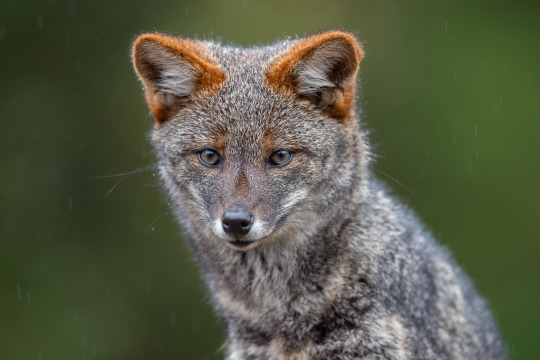
Darwin’s foxes are not actually foxes. True foxes belong to the vulpes genus, and these foxes belong to the lycalopex genus. They share this genus with the Sechuran fox, the hoary fox, the pampas fox, the culpeo, and the chilla. It was believed for a long time that the Darwin’s fox was a subspecies of the chilla, but they are now classified as a different species.
While most South American fox species prefer open grassland or scrub areas, Darwin’s foxes prefer dense forests. They are endemic to Chile, meaning they are only found there, with most individuals found on Chiloé island and in the Valdivian Coastal Range.
In these forests, Darwin’s foxes hunt for small animals like rodents and lizards along with fruit, eggs, beetles, and carrion. They are not strictly nocturnal, diurnal, or crepuscular, so they just hunt when they want to.

Like almost all other fox species, Darwin’s foxes prefer to live alone, only living in pairs during the breeding season and when they have kits.
Due to habitat loss, feral dogs, and being hunted for their fur, Darwin’s foxes are highly endangered with less than 1,000 individuals left. Conservation efforts have grown their population by small amounts but they are still in danger of extinction.
I rate this very curious fox 18/10. They may be “less wise” than other foxes but their charisma makes up for that
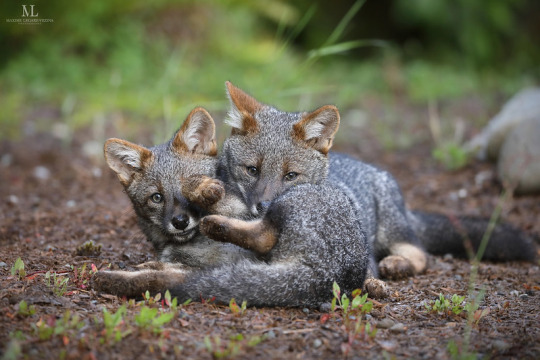

Photo Credits:
(1) Jono Dashper (2) Unknown (3) Maxime Legare-Vezina (4) Kevin Schafer
#Darwin’s fox#fox#animal#animals#nature#wildlife#canine#wild animals#world#canid#dog#foxes#zoology#biology#science#best animal ever#canines#dogs#south america#South American fox#charles darwin#Darwin
972 notes
·
View notes
Text
Lycalopex griseus
Also known as South American gray foxes or gray zorros, chillas are a species of false fox. This means they are called foxes but aren’t actually foxes; they are more closely related to coyotes, wolves, and jackals.

Chillas are found in Argentina and Chile where they live in rocky areas in the Andean Mountains as well as in grasslands and scrub. Chillas are classified as least concern, meaning they’re not in danger of extinction, although they are rare in some places because they are hunted for their fur.
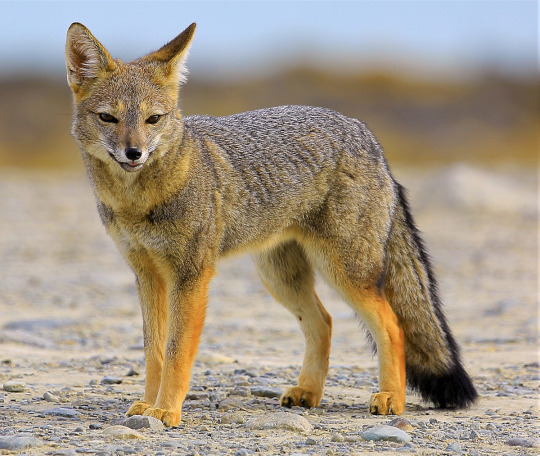
Like most other fox species, chillas are omnivores. While most of their diet consists of small mammals, they also eat carrion, birds, eggs, and fruit. Since chillas mostly eat small mammals and many small mammals are most active at night, chillas are often nocturnal. Some populations of chillas are more active during the day (diurnal) or at dawn and dusk (crepuscular). Usually this is the case when they eat fewer small mammals and more fruit or birds.
Also similar to other fox species, chillas are very solitary animals. They usually only socialize with other foxes during the breeding season and when they have litters of kits. These litters are very small, usually consisting of only 2-4 kits.
I rate the chilla 10/10. It’s like a mini coyote
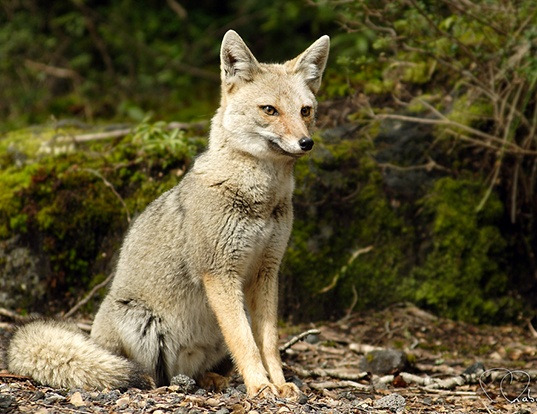

Photo Credits:
(1) Daniele Colombo (2) Antony King Photography (3) Unknown (4) Daniel Sziklai G.
#grey fox#animal#animals#nature#wildlife#fox#canine#wild animals#world#dog#canid#South American grey fox#chilla#chilla fox#andean mountains#mountains#andean fox
16 notes
·
View notes
Text
Lycalopex Culpaeus
South American foxes, also know as zorros, aren’t really foxes- they are more closely related to wolves, coyotes and jackals. The culpeo is the largest South American fox species, weighing from 12 to 30 pounds (5-13.5 kg).

Culpeos are essentially the coyotes of South America. They are highly adaptable animals and live in a variety of habitats in western South America. These habitats include mountains, coastal beaches, plains, and deserts. Their distribution extends all the way from Ecuador and Peru to southern Patagonia.
Since most of their prey is active at night the culpeo is primarily nocturnal, although some populations are more active during the day (diurnal) or at dusk and dawn (crepuscular). Their diet consists mostly of rodents and rabbits but they also prey on lizards, birds, plants, carrion, and occasionally sheep, which makes them a target for shepherds.


Culpeos are very solitary animals, only seen in pairs during the breeding season and when they have pups. Even though they are very solitary and attack sheep, people attempted to domesticate them. This attempt didn’t go very well and the result, called a Fuegian dog or Yaghan dog, was only around until the early 1900′s. The dogs were used for hunting otters but they were apparently not loyal to their owners and frequently attacked livestock.
I rate the culpeo 14/10. They may have been bad dogs but they are very good foxes
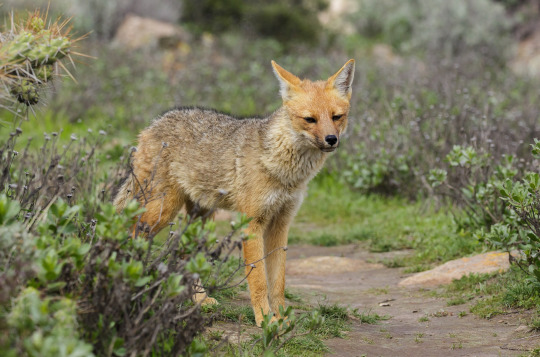

Photo Credits:
(1) Torsten Klein (2) Bernardo Segura (3) doglime.com (4) Thomas Fuhrmann (5) Joel Sartore
#culpeo#fox#andean fox#foxes#culpeos#south america#canine#canines#dog#dogs#animal#animals#nature#wildlife#zoology#biology#science
1K notes
·
View notes
Text
Lycalopex gymnocercus
Pampas foxes are a medium sized fox species, weighing from 8.8 - 13.2 pounds (4 - 6 Kgs). They have a unique ability to play dead when threatened.

Because they aren’t in the vulpes genus, Pampas foxes aren’t actually foxes. Like the hoary fox, Sechuran fox, and three other fox species in their lycalopex genus, they are more closely related to jackals and coyotes than they are to true foxes.
These foxes are named after the Pampas, which are large, fertile grasslands in South America. These grasslands cover 460,000 square miles (1,200,000 sq km) in Argentina, Uruguay, and a very small part of southern Brazil. The Pampas fox lives all throughout this region as well as other grassland regions in central South America.

Like most fox species, Pampas foxes are omnivores. This means they eat both animals and plants, although they prefer eating meat. They’ll eat birds, rodents, armadillos, hares, invertebrates, and other small animals along with fruit, carrion, and eggs. And if they live around people, they also enjoy eating garbage.
Pampas foxes are very solitary, but they can be found in pairs during the breeding season and when they have kits. Both parents care for the litters which consist of up to eight kits. These kits are raised in dens which are often dug by other animals like armadillos.
I rate the Pampas fox 18/10. These dramatic dogs earn a very high rating from their habit of pretending to die instead of running from a threat.

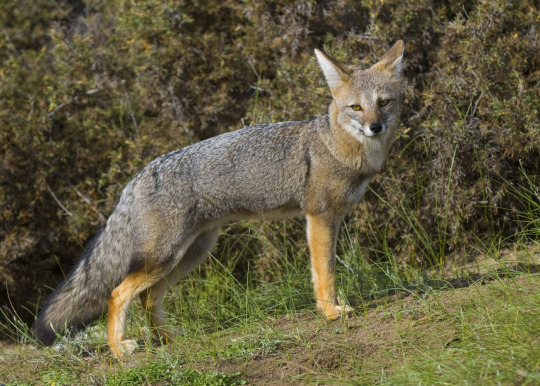

Photo Credits:
(1) Pablo Fraire (2) Agustinzar, Creative Commons (3) Wolf Education and Research Center (4) Unknown (5) Jarbas Mattos
#pampas fox#fox#animal#animals#nature#zoology#biology#science#dog#canine#dogs#foxes#canines#wildlife#wild#pampas#south america
42 notes
·
View notes
Text
Lycalopex Vetulus
The hoary fox is part of the lycalopex genus, meaning they aren’t real foxes and are more closely related to coyotes and jackals. They share the lycalopex genus with the sechuran fox from the previous post and four other “false” foxes.

Hoary foxes are endemic to Brazil. This means they are native to Brazil and they aren’t found anywhere else. They are specifically native to the Cerrado of Brazil, which is a huge tropical savanna.
These foxes get their name from the color hoary, which is grayish-white like the foxes’ fur. In Brazil they are called raposinha-do-campo, which is Portuguese for “meadow fox.”

Weighing from 6 to 9 pounds (3 to 4 kg), hoary foxes are roughly the same size as a house cat. The foxes’ slender build allow them to be very agile and fast, making them efficient hunters. They are omnivores, hunting small rodents, birds, and reptiles, although most of their diet consists of fruit and insects.
Like the Sechuran fox, hoary foxes are very solitary until the breeding season and when they have kits. They have very small litters that they raise in a den. Usually this den is taken over from an animal like an armadillo.
I rate the hoary fox 14/10. They look friendly.


Photo credits:
(1) Unknown (2) Arthur Anker (3) Rafael Martos Martins (4) Joel Sartore
#hoary fox#fox#zorro#zoology#biology#science#nature#wildlife#world#animal#animals#foxes#south america
73 notes
·
View notes
Text
Lycalopex Sechurae
This is a Sechuran fox, also called a Peruvian desert fox. They are the smallest fox species in South America.

Sechuran foxes live in the coastal regions of Peru and Ecuador. These foxes aren’t a part of the vulpes genus, meaning they aren’t actually foxes- they are more closely related to coyotes and jackals. Sechuran foxes are part of the lycalopex genus which they share with five other south american fox species. All these South American fox species are called zorros.


Sechuran foxes are highly adaptable animals, meaning they can thrive in many different habitats. These include tropical forests, deserts, beaches, and plains. They eat just about anything they find in these habitats, including fruit, seed pods, fish, eggs, insects, carrion, and rodents, which they hunt for at night. They can survive for a long time with no water, getting all they need from their food.
Since they prefer to hunt at night, sechuran foxes spend the day in a burrow. They’re solitary animals and are usually alone, but they occasionally travel in pairs.
Mostly due to habitat loss, the sechuran fox is listed as Near Threatened. This means that it isn’t endangered but might be in the near future. There are an estimated 15,000 individuals in the wild.
I rate the sechuran fox 10/10. Very resourceful animal.

Photo credits:
(1) Unknown (2) Gavin Edmondstone (3) Ian Davis (4) triggsturner
#sechuran fox#fox#south america#animal#animals#nature#wildlife#wild animals#biology#zoology#science#foxes#canine#canid#dog#dogs#canines
515 notes
·
View notes
Text
Vulpes Vulpes
The red fox is the largest of all fox species with an average weight of 10 pounds. They are also the most widespread of any terrestrial carnivore species, found in most of North America, Europea, Asia, and Australia, and some parts of North Africa. There are over 45 subspecies.

Although they have been known to form large groups, red foxes generally live alone, in pairs, or in a small family group. These family groups consist of the parent foxes and their kits. Kits from their previous litters sometimes help raise other litters.
Like most other fox species, red foxes are solitary hunters. They have omnivorous diets that include rodents, rabbits, birds, fruit, insects, and fish. Rodents are their main prey, and because rodents are most active at night, Red foxes are nocturnal. Their eyesight is more similar to a cat than a dog, allowing them to see well in the dark.
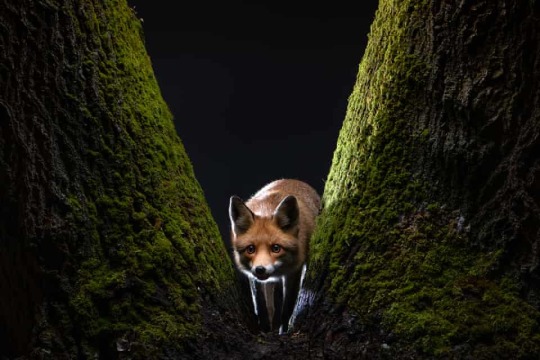
The photo below on the left shows an Arabian red fox, a subspecies of red fox found in the Arabian desert. With a very slender body, big ears, and short fur, they have adapted to the harsh desert environment. They look quite similar to Ruppell’s foxes, but Arabian red foxes are generally taller and thinner and they don’t have black under their eyes, unlike the Ruppell’s foxes. Other subspecies of the red fox include the white-footed fox of northwest India and the Sierra Nevada red fox. The Sierra Nevada red fox is extremely endangered with only around 50 individuals remaining. Those are only three of the 45 subspecies.
The image on the right shows a melanistic red fox. Melanism is kind of the opposite of albinism, which makes them white. The name “red fox” can be misleading since not all red foxes are actually red. Red is the most common coat color, but they can also be black, silver, white, brown, or anything in between.

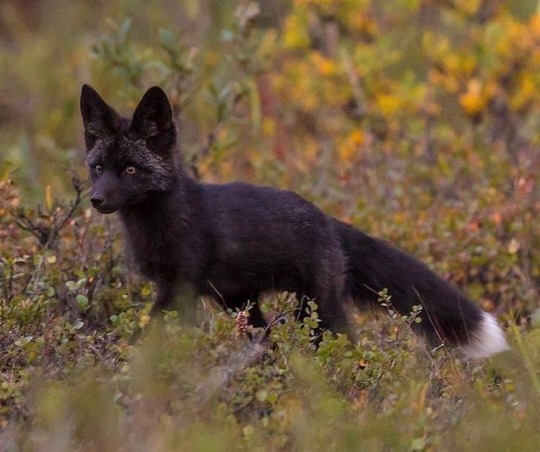
What does the fox say?
Red foxes have a vocabulary of around 12 sounds. These include screams, barks, whimpers, and gekkering, which is a chattering sound used in fights between adult foxes and play in young foxes. The screams and barks are very loud and useful for finding mates and defending their territories, and the whimpers are useful for communicating with kits. Red foxes are very good at communicating with each other, helping to avoid conflict.

I rate the red fox 17/10. Absolutely love these guys

Photo credits:
(1) Gary Hall (2) Milan Radisics (3) birdsofsaudiarabia.com (4) Unknown (5) Roeselien Raimond (6) Ray Hennessy
107 notes
·
View notes
Text
Vulpes Velox
These little foxes are called swift foxes, named for their ability to run really fast. They can reach speeds of 30-40 mph. Swift foxes look quite similar to the kit fox from the previous post, but their ears are smaller and pointier than those of the kit fox and their tails are shorter. They look like a bad taxidermy job of the kit fox (respectfully).

Kit foxes and swift foxes are so similar in size, coloration, habitat, and behavior that researchers debate whether they are really different species. They are currently classified as different species but they might be different subspecies of the same kind of fox.
The range of the swift fox overlaps in some places with the range of the kit fox, but swift foxes are generally found farther East in the Great Plains.

After wolves were mostly hunted to extinction in the places where swift foxes live, the coyote population greatly increased. Coyotes are the swift fox’s main predator, so the swift fox population dramatically decreased and they were listed as an endangered species. They were taken off the endangered species list in 2001 after a successful program increased their population. Their population is currently classified as least concern, meaning it’s stable.
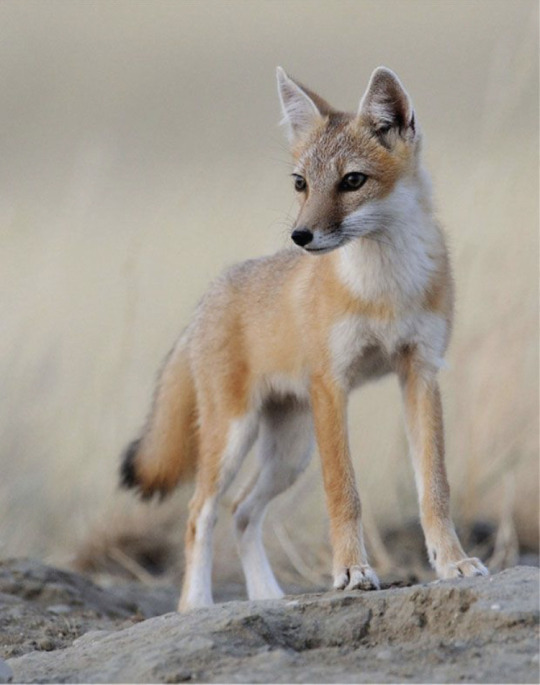
Like kit foxes, swift foxes are heavily dependent on their dens. They use these dens to raise kits and hide from predators which include coyotes, eagles, and bobcats. They can be found in some parts of Canada and northern United States, so they also need these dens to shelter from cold weather.
I rate this fox 10/10. Great little pointy ears

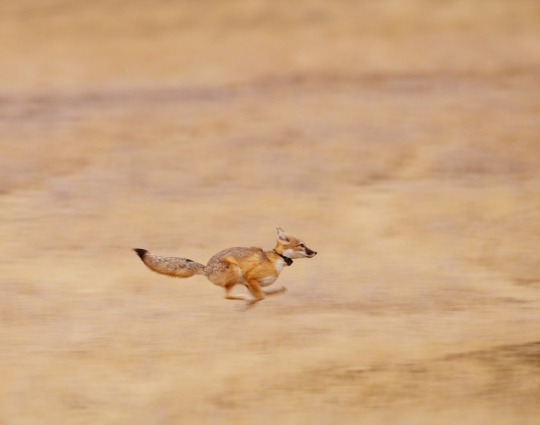
Photo credits:
(1) Gerard W. Beyersbergen (2) Daniel Stiel (3) Gordon Court (4) Pat Gaines (5) Smithsonian Conservation Commons
339 notes
·
View notes
Text
Vulpes Macrotis
There are four true fox species in North America including the red fox, arctic fox, swift fox, and kit fox. Kit foxes are the smallest of these four, weighing about 5 pounds (lighter than the average house cat).

Kit foxes live in southwestern North America, preferring dry climates like the Mojave and Sonoran desert. These regions can get quite hot and kit foxes are poorly adapted to the heat. Because of this, kit foxes shelter in a burrow during the day. They can dig these burrows but they more commonly enlarge abandoned burrows made by animals like badgers or prairie dogs, often adding extra entrances. In more mountainous regions they use rock outcroppings as dens. They come out of these burrows at night to hunt for animals like kangaroo rats, cottontail rabbits, prairie dogs, lizards, and ground-dwelling birds. They’ll also eat vegetation like cactus fruits and tomatoes.
The population of the kit fox is classified as least concern, meaning they aren’t at risk for extinction, but their population is decreasing due to habitat loss and poisons used to kill rodents and insects. The San Joaquin kit fox subspecies is endangered for these reasons.

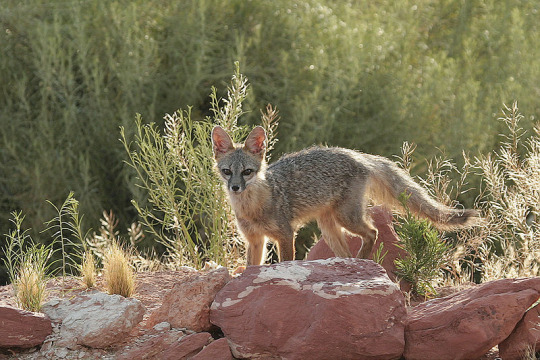
Like all other fox species, kit foxes hunt alone. They are quite social, though, and live in pairs or small family groups. They aren’t very territorial either, so the territory of different groups of kit foxes often overlap.
I rate the kit fox 15/10. Definitely would pet

Photo credits:
(1) Jason Sims (2) Joel Sartore (3) Utahcamera on Wikipedia (4) Jason Sims
205 notes
·
View notes
Text
Vulpes Bengalensis
Bengal foxes, also known as Indian foxes, are found primarily in India with parts of their range extending into Pakistan, Nepal, and Bangladesh. Although they are the most widespread fox species in India, very little research has been done on them.

The population of the bengal fox is classified as least concern, meaning they are not facing extinction, but their population is decreasing due to habitat loss and disease. Bengal foxes are very bold and are fine living close to people, so habitat loss doesn’t affect them as severely as it affects animals like Bengal tigers.
Bengal foxes are omnivores. Their diets consist mostly of small rodents, birds, reptiles, and fruit, particularly mango. Foxes that live near people will gladly eat human food as well.
Because they are so bold around people, Bengal foxes are supposedly quite docile.

Based on very small amounts of research, it seems that Bengal foxes form pairs that stay together for many years. They also show strong den fidelity, which means that once they find a nice den they will return to that den year after year. They usually have 2-4 kits which are born in this den.
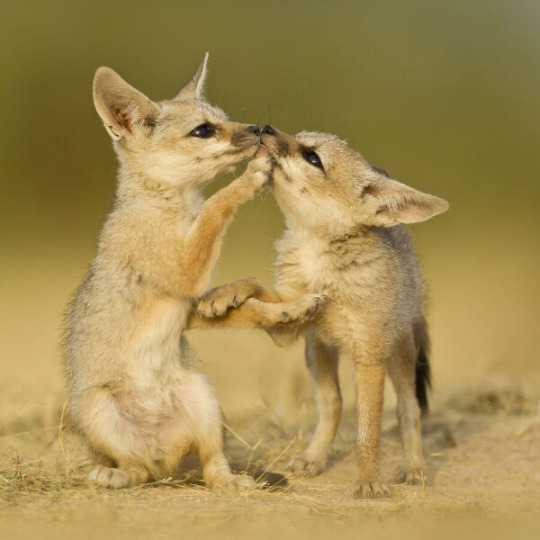
I rate this fox 12/10. Very pretty with an amazing fluffy tail. They deserve more attention from researchers.
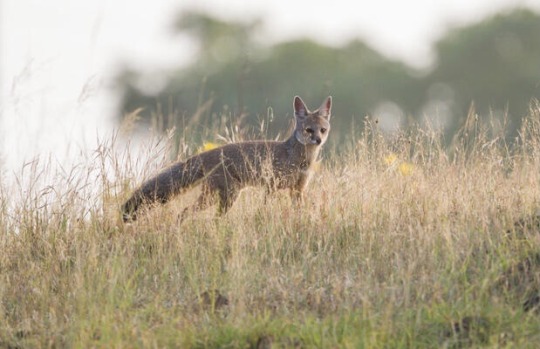

Photo Credits:
(1) Samyak Kaninde (samyakphoto on Instagram) (2) Neelutpaul Barua (3) Sandesh Kadur (4) Samyak Kaninde (samyakphoto on Instagram) (5) Rohit Varma
#bengal fox#Indian fox#fox#animal#animals#nature#wildlife#world#wild animals#canine#canid#dog#foxes#India#Asian animals
189 notes
·
View notes
Text
Vulpes Corsac
Closely related to the Tibetan sand fox, corsac foxes are a medium-sized fox species found in Central Asia.

Corsac foxes live in the grasslands and semi-arid desert regions of Central Asia, particularly in northern China, Mongolia, and Kazakhstan.
The population of the corsac fox is classified as least concern, meaning they aren’t at risk for extinction, but populations change dramatically from year to year because they are hunted for their fur.

The diet of the corsac fox consists mostly of rodents and other small animals. They occasionally hunt larger prey like rabbits and pikas, and when food is scarce they will eat vegetation. Nobody likes salad so it’s understandable that they only resort to this when nothing else is available.

Corsac foxes don’t live in a defined territory, instead preferring a nomadic lifestyle. They occasionally form groups to hunt, but they usually just form pairs. They hunt at night to avoid predators like wolves and eagles.
They have trouble hunting in snow, so during the winter they often travel south or shelter in burrows. They can dig their own burrows, but they aren’t very good at it so they usually take over abandoned animal dens. Being more social than most fox species, they often share these dens with other foxes.
I rate the corsac fox 10/10. Adorable little nomads

Photo Credits:
(1) Joel Sartore (2) Aleksandr Leshchonok (3) Unknown (4) Joel Sartore
#animal#animals#nature#wildlife#world#fox#wild animals#canine#canid#dog#corsac#corsac Fox#asia#asian animals#foxes#steppe fox#cute animals
393 notes
·
View notes
Text
Vulpes Pallida
Mostly due to its remote habitat and well-camouflaged coat, the pale fox is one of the least studied canines in the world.
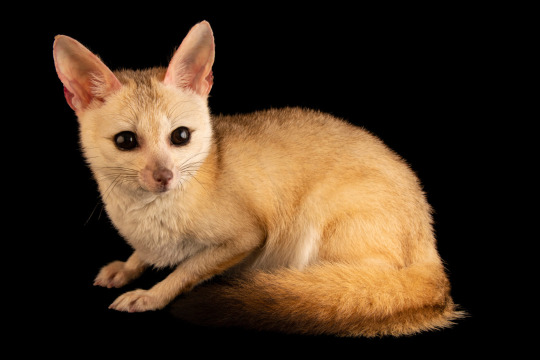
Pale foxes are usually found in the southern section of the Sahara desert. They share this habitat with fennec foxes and Ruppell's foxes. Pale foxes’ range also extends further south to wetter habitats like the Guinean savannah (see image below). If I was a pale fox I would definitely prefer living there.

Pale foxes are gregarious animals, which means they are quite social. They generally share a burrow with a couple other foxes. This burrow is large, and it has multiple chambers lined with grasses and other vegetation. They spend the day in this burrow, coming out at night to hunt. They have no known predators, so they probably only do this to avoid the hot desert temperatures.
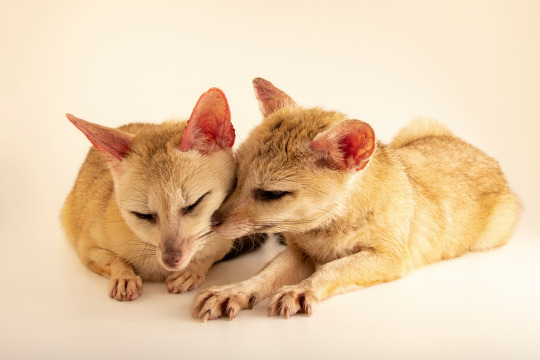
Like most foxes, pale foxes will eat almost anything. This includes eggs, reptiles, insects, carrion, and vegetation like wild melons. The pale fox’s ears aren’t as giant as the fennec or Ruppell’s foxe’s, but they still have excellent hearing that allows them to find prey under sand. They also have quite short legs. This makes it easier for them to navigate tunnels and stay hidden in grass.
I rate the pale fox 11/10 absolutely amazing


Photo credits:
(1) Joel Sartore (2) Lindsay Stark (3) Joel Sartore (4) Doug Macdonald (5) Christian Artuso
#pale fox#pallid fox#fox#animal#animals#nature#wildlife#world#wild animals#canine#canid#dog#African animals
502 notes
·
View notes
Text
Blanford’s fox- Vulpes Cana
These guys deserve so much more attention

Blanford’s foxes, also known as the Afghan fox or royal fox, are found in the mountainous regions of the Middle East and Central Asia, particularly in Afghanistan and surrounding countries. They are excellent climbers, using their cat-like claws and bare paw-pads to grip narrow ledges, and they can supposedly jump to ledges nearly 10 feet above them. Their ginormous tails, which are roughly the same size as their bodies, help them balance on these ledges. It also helps them look very nice.
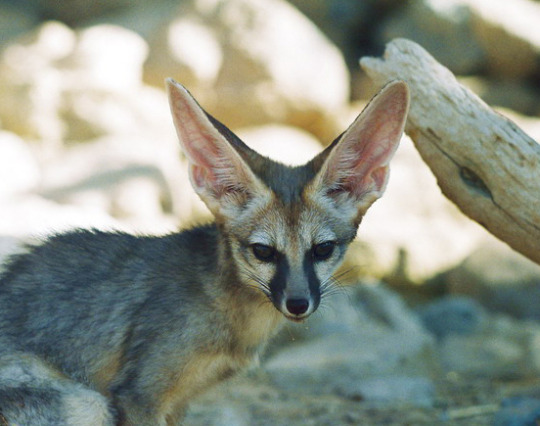
While most fox species have omnivorous diets of insects, plants, and small animals, the diet of the Blanford’s fox consists almost entirely of insects and fruit. This fruit includes dates, grapes, and various kinds of melons. They forage for this food at night to avoid predators, spending the day in a cave or rocky den.
I rate the Blanford’s fox 13/10 just look at those ears and that tail


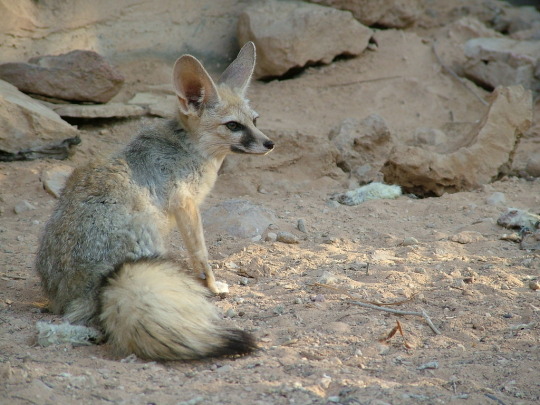
Photo credits:
(1) Mike Hill (2) David Blank (3) David Blank (4) Klaus Rudloff (5) Aviad Bar
#fox#animal#animals#nature#wildlife#world#wild animals#canine#canid#dog#blanford fox#blanford’s fox#vulpes#vulpes cana#fox enjoyers
750 notes
·
View notes
Text
Vulpes Rueppellii
Named after the German Naturalist Eduard Ruppell, the Ruppell’s fox (or Ruppell’s sand fox) is one of the twelve species of true foxes. Found in the dry regions of North Africa, Saudi Arabia, Iran, Pakistan, and Afghanistan, these small foxes are very well adapted to life in the desert. They have huge ears to keep them cool and allow them to hear small prey, a light-colored coat that helps them camouflage and stay cool, and fur on the bottom of their feet to protect their paw-pads and help them run faster in sand.
Because they share all these traits with the fennec fox, the two are often confused with one another. Adult Ruppell’s foxes are slightly taller than fennec foxes and their coats are darker in color, but young Ruppell’s foxes are often almost indistinguishable from adult fennec foxes. If you ever need to distinguish between the two of them, look at the tail-tip. Ruppell’s foxes have white on the end of their tails while fennec foxes have black.
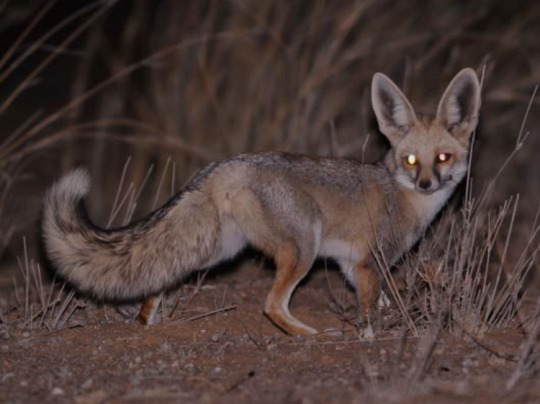
Like the fennec fox, Ruppell’s foxes prefer cold temperatures over hot temperatures, so they are crepuscular or nocturnal. They spend the day in a burrow, moving to new burrows every 4-6 days. It’s unclear why they do this, but it probably helps them avoid predators like jackals. These burrows are quite small, so when they have kits they move to a slightly larger burrow. Unlike most fox burrows, theirs very rarely have multiple entrances.
Water can be hard to find in the Ruppell’s fox’s desert habitat. As legend has it, the foxes drink by raising their heads to the breeze and getting water from the wind. Really, though, they get almost all the water they need from their prey. They are omnivores, so this prey includes plants, birds, insects, lizards, and small mammals.
I rate the Ruppell’s Fox 10/10. I want one




Photo credits:
(1) Unknown (2) Unknown (3) Theklan; only name given (4) Stuart; only name given lol (5) Jonas; only name given
#ruppell’s fox#fox#sand fox#desert#Sahara desert#animal#animals#nature#wildlife#world#wild animals#canine#canid#dog
327 notes
·
View notes
Text
Vulpes Chama
The cape fox lives in the dry kalahari desert areas in Botswana, Namibia, and South Africa. With big ears like the fennec fox, the larger cape fox also lives quite similarly. They are nocturnal to avoid the scorching desert temperatures, and they are omnivores, eating whatever is available. In the Kalahari desert this includes reptiles, insects, vegetation, rodents, and small farm animals, which makes them a target for farmers. They get most of their water from this food and very rarely actually drink water.

Little is known about the social structure of the cape fox, although they seem to be very solitary, only interacting with other foxes during the breeding season and when they have kits. They generally have 1-6 kits, and both parents help raise them. Although they are very solitary animals, their territories often overlap with other foxes’ territories.
I rate the cape fox 10/10. Cute and soft-looking

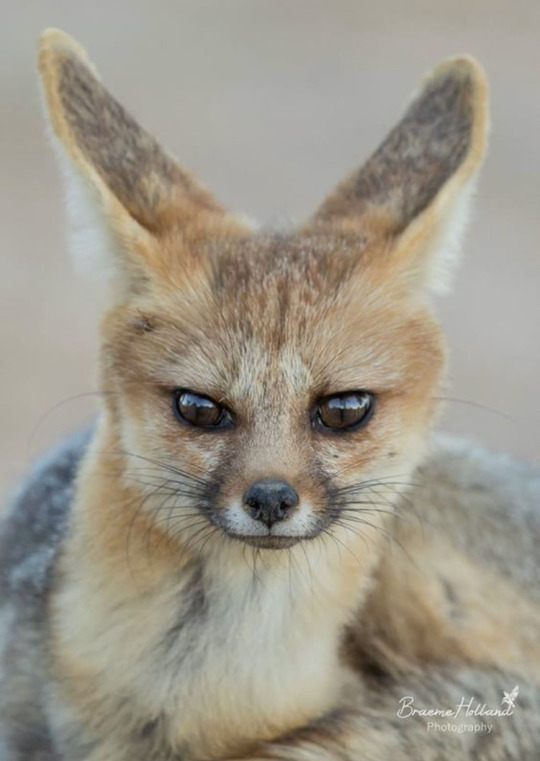
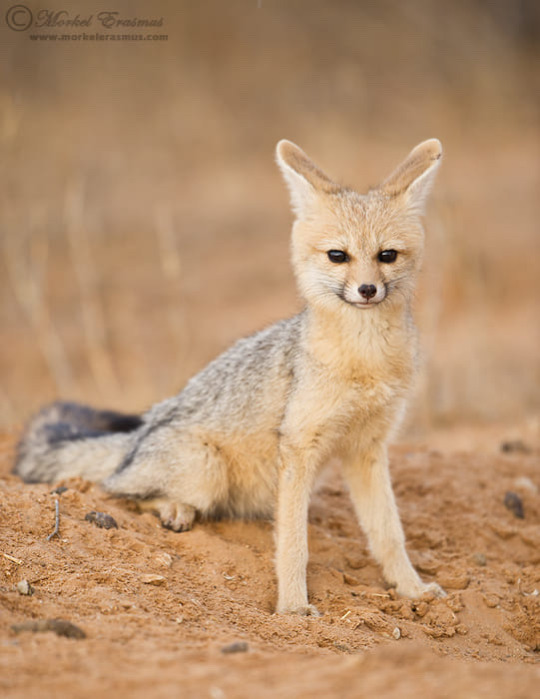

Image creds:
(1) Jens Böhme (2) Braeme Holland braemehollandphotography.com (3) Shem Compion (4) Morkel Erasmus (5) Johan J. Botha johanjbotha.com
#cape fox#fox#cama fox#animal#animals#nature#wildlife#world#wild animals#canine#canid#dog#South Africa#africa
205 notes
·
View notes